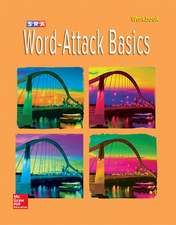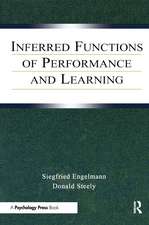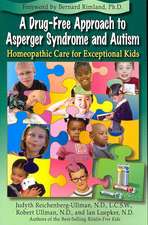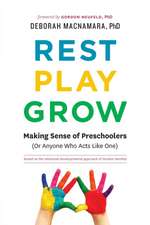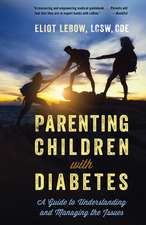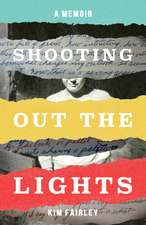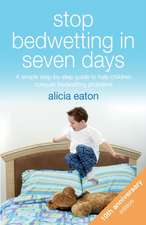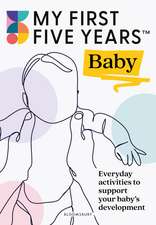Teach Your Child to Read in 100 Easy Lessons: Revised and Updated Second Edition
Autor Phyllis Haddox, Elaine Bruner, Siegfried Engelmannen Limba Engleză Paperback – iun 1986
With more than one million copies sold, Teach Your Child to Read in 100 Easy Lessons is a remarkable step-by-step program that teaches your child to read in just 20 minutes a day—with love, care, and joy only a parent and child can share.
“[A] magical book...I’ve seen this method work in my own home, having used it with both of my children and watched that light go on.” —John McWhorter, The New York Times
Is your child halfway through first grade and still unable to read? Is your preschooler bored with coloring and ready for reading? Do you want to help your child read, but are afraid you’ll do something wrong?
Teach Your Child to Read in 100 Easy Lessons is a complete, step-by-step guide that shows parents simply and clearly how to teach their children to read.
Twenty minutes a day is all you need, and within 100 teaching days your child will be reading on a solid second-grade reading level. It’s a sensible, easy-to-follow, and enjoyable way to help your child gain the essential skills of reading. Everything you need is here—no paste, no scissors, no flash cards, no complicated directions—just you and your child learning together. One hundred lessons, fully illustrated and color-coded for clarity, give your child the basic and more advanced skills needed to become a good reader.
Preț: 184.54 lei
Nou
35.31€ • 36.87$ • 29.16£
Carte disponibilă
Livrare economică 25 martie-08 aprilie
Livrare express 11-15 martie pentru 87.39 lei
Specificații
ISBN-10: 0671631985
Pagini: 420
Dimensiuni: 213 x 279 x 25 mm
Greutate: 0.93 kg
Ediția:Fireside.
Editura: Avid Reader Press / Simon & Schuster
Colecția Avid Reader Press / Simon & Schuster
Notă biografică
Siegfried Engelmann, Phyllis Haddox, and Elaine Bruner
Extras
LESSON 1
TASK 1 SOUNDS INTRODUCTION
1. (Point to m)I'm going to touch under this sound and say the sound. (Touch first ball of arrow. Move quickly to second ball. Hold two seconds.) mmmmmm. (Release point.)
2. Your turn to say the sound when I touch under it. (Touch first ball.)Get ready. (Move quickly to second ball. Hold.) "mmmmmm."
(To correct child saying a wrong sound or not responding:) The sound is mmmmmm. (Repeat step 2.)
3. (Touch first ball.)Again. Get ready. (Move quickly to second ball. Hold.) "mmmmmm." (Repeat three more times.)
4. (Point to s.)I'm going to touch under this sound and say the sound. (Touch first ball of arrow. Move quickly to second ball. Hold.) ssssss. (Release point.)
5. Your turn to say the sound when I touch under it. (Touch first ball.)Get ready. (Move quickly to second ball. Hold.) "ssssss."
(To correct child saying a wrong sound or not responding:) The sound is ssssss. (Repeat step 5.)
6. (Touch first ball.)Again. Get ready. (Move quickly to second ball. Hold.) "ssssss." (Repeat three more times.)
TASK 2 SAY IT FAST
1. Let's play say-it-fast. My turn: motor (pause) boat. (Pause.) Say it fast. motorboat.
2. Your turn. Wait until I tell you to say it fast. motor (pause) boat. (Pause.) Say it fast. "motorboat." (Repeat step 2 until firm.)
(To correct child saying word slowly -- for example, "motor [pause] boat":) You didn't say it fast. Here's saying it fast: motorboat. Say that. "motorboat." Now let's do that part again. (Repeat step 2.)
3. New word. Listen: ice (pause) cream. (Pause.) Say it fast. "icecream."
4. New word. Listen: sis (pause) ter. (Pause.) Say it fast. "sister."
5. New word. Listen: ham (pause) burger. (Pause.) Say it fast. "hamburger."
6. New word. Listen: mmmeee. (Pause.)Say it fast. "me."
7. New word. Listen: iiifff. (Pause.)Say it fast. "if."
8. (Repeat any words child had trouble with.)
TASK 3 SAY THE SOUNDS
1. I'm going to say some words slowly, without stopping. Then you'll say them with me.
2. First I'll say am slowly. Listen: aaammm. Now I'll say me slowly. Listen: mmmeee. Now I'll say in slowly. Listen: iiinnn. Now I'll say she slowly. Listen: shshsheee.
3. Now it's your turn to say the words slowly with me. Take a deep breath and we'Il say aaammm. Get ready. "aaammm."
(To correct if child stops between sounds -- for example, "aaa [pause] mmm":) Don't stop. Listen. (Don't pause between sounds a and m as you say aaammm.) Take a deep breath and we'll say aaammm. Get ready. "aaammm." (Repeat until child responds with you.)
4. Now we'll say iiinnn. Get ready. "iiinnn." Now we'll say ooonnn. Get ready. "ooonnn."
5. Your turn to say words slowly by yourself. Say aaammm. Get ready. "aaammm." Say iiifff. Get ready. "iiifff." Say mmmeee. Get ready. "mmmeee." Good saying the words slowly.
TASK 4 SOUNDS REVIEW
1. Let's do the sounds again. See if you remember them. (Touch first ball for m,) Get ready. (Quickly move to second ball. Hold.) "mmmmmm."
2. (Touch first ball for s.) Get ready. (Quickly move to second ball. Hold.) "ssssss."
TASK 5 SAY IT FAST
1. Let's play say-it-fast again. Listen: motor (pause) cycle. Say it fast. "motorcycle."
2. mmmeee. (Pause.) Say it fast. "me." iiifff. (Pause.) Say it fast. "if." shshsheee. (Pause.) Say it fast. "she."
TASK 6 SOUNDS WRITING
(Note: Refer to each symbol by its sound, not by its letter name. Make horizontal rules on paper or a chalkboard about two inches apart. Separate writing spaces by spaces about one inch apart. Optionally, divide writing spaces in half with a dotted line:-----.)
1. See chart on page 24 for steps in writing m and s.) You're going to write the sounds that I write. You're going to write a sound on each line. I'll show you how to make each sound. Then you'll write each sound. Here's the first sound you're going to write.
2. Here's how you make mmm. Watch. (Make m at the beginning of first line. Start with a vertical line:
Then add the humps:
(Point to m.) What sound? "mmm." First you're going to trace the mmm that I made. Then you're going to make more of them on the line.
3. (Help child trace sound two or three times. Child is then to make three to five m's on top line. Help child if necessary. For each acceptable letter child makes, say:) Good writing mmm.
4. Here's how to make sss. Watch. (Make s at beginning of second line. Point to s.) What sound? "sss."
5. First you're going to trace the sss that I made. Then you're going to make more of them on the line. (Help child trace sound two or three times. Child is then to make three to five s's on second line. Help child if necessary. For each acceptable letter child makes, say:) Good writing sss.
LESSON 2
TASK 1 SOUNDS REVIEW
1. (Point to m.) I'm going to touch under this sound and say the sound. (Touch first ball of arrow. Move quickly to second ball. Hold two seconds.) mmmmmm. (Release point.)
2. Your turn to say the sound when I touch under it. (Touch first ball.) Get ready. (Move quickly to second ball. Hold.) "mmmmmm."
(To correct child saying a wrong sound or not responding:) The sound is mmmmmm. (Repeat step 2.)
3. (Touch first ball.) Again. Get ready. (Move quickly to second ball. Hold.) "mmmmmm." (Repeat three more times.)
Copyright © 1983 by Siegfried Engelmann
Recenzii
"With its short lessons, intuitive alphabet, clear lessons and hands-on learning component, Teach Your Child to Read in 100 Easy Lessons can be an easy, compact and affordable way for parents to get children reading quickly." —Anne Miller, The Smarter Learning Guide
"Teach Your Child to Read in 100 Easy Lessons is incredible. I owe this book, author and method a huge thank you—my daughter can read now, and more importantly, reads for fun. Plus, it's an interesting way to teach phonics I hadn't seen before." —David Weller, The Barefoot TEFL Teacher
“While working within a university-school partnership, I trained, supervised, and guided my teacher candidates as they implemented Teach Your Child to Read in 100 Easy Lessons with the lowest performing first grade readers at a large urban elementary school. Semester after semester, I witnessed children who were considered 'nonreaders' or poor readers advance to reading with joy and confidence and candidates who became skilled and proud of their newfound craft.” —Dr. Susan Syverud, Ph.D
"I have spent years of my life being passionate about literacy and reading... In college I took a path that led me to keep teaching younger and younger children, trying to figure out why they were not prepared until I began directing childcare centers in 2015. I keep hearing/finding the same things. Children are not being taught to read! And parent/teachers have no idea this is happening until about 2nd or 3rd grade. The main reading curriculum is not scientifically researched or backed! Being an educator in this work, I recognize all the care, thought and research it takes to create a resource like this that is so easy for children and facilitators to understand and teach!” —Brittany Lemons, Family and Community Engagement Specialist–Birth to Five Illinois
Descriere
With more than one million copies sold, Teach Your Child to Read in 100 Easy Lessons is a remarkable step-by-step program that teaches your child to read in just 20 minutes a day—with love, care, and joy only a parent and child can share.
“[A] magical book...I’ve seen this method work in my own home, having used it with both of my children and watched that light go on.” —John McWhorter, The New York Times
Is your child halfway through first grade and still unable to read? Is your preschooler bored with coloring and ready for reading? Do you want to help your child read, but are afraid you’ll do something wrong?
Teach Your Child to Read in 100 Easy Lessons is a complete, step-by-step guide that shows parents simply and clearly how to teach their children to read.
Twenty minutes a day is all you need, and within 100 teaching days your child will be reading on a solid second-grade reading level. It’s a sensible, easy-to-follow, and enjoyable way to help your child gain the essential skills of reading. Everything you need is here—no paste, no scissors, no flash cards, no complicated directions—just you and your child learning together. One hundred lessons, fully illustrated and color-coded for clarity, give your child the basic and more advanced skills needed to become a good reader.


